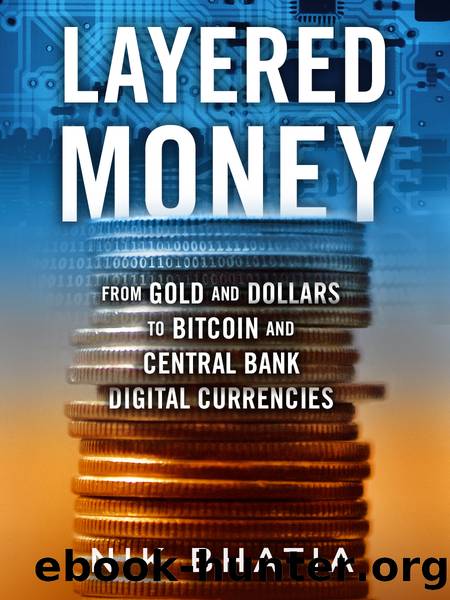Layered Money. From Gold and Dollars to Bitcoin and Central Bank Digital Currencies by Nik Bhatia

Author:Nik Bhatia
Language: eng
Format: epub
ISBN: 978-1-7361105-0-8
Published: 2021-01-15T00:00:00+00:00
Falling into Disrepair
Despite cracks in the dollar pyramidâs foundation that surfaced after the LTCM bailout, money market interest rates portrayed a sturdier facade. U.S. Treasury Bills, Fed Funds, Eurodollar LIBOR, and Treasury Repo GC rates all closely tracked each other for years. Small divergences would occur but were always characterized as the result of seasonal or idiosyncratic factors. That would all change starting on August 9, 2007. On that day, LIBOR rose by what might seem like a paltry 0.12% relative to the rest of the family of money market rates, but it was the start of something dramatic. The night before, French bank BNP Paribas was unwilling to value certain derivatives and froze all cash withdrawals for funds holding financial instruments related to risky American home borrowers. A sudden jolt of distrust electrocuted the interbank funding market in the weeks to follow. Banks were afraid to lend money to each other in any capacity because they werenât sure which banks might not open back up the next day. The era of unlimited, almost care-free interbank exposure had ended, replaced by extreme caution and nervousness. The ascent up the dollar pyramid had begun.
On December 12, 2007, the Federal Reserve was finally forced to address the gargantuan elephant in the room, which was that European interbank trust and the âbookkeeperâs penâ Eurodollar funding mechanisms had broken down. A contraction in European interbank trust, expressed by a rising LIBOR, was causing the whole dollar pyramid to rattle like an earthquake. The Fed instituted foreign exchange swap lines to the European Central Bank and Swiss National Bank in order to provide liquidity to the offshore banking system, having to turn a blind eye to the practice of creating dollar liabilities outside the Fedâs purview. The Fedâs role as lender of last resort had expanded beyond its borders because of the complicated evolution of the international monetary system, not because its mandate all of a sudden switched from domestic to global monetary policy. This conundrum was neither escapable nor up for discussion considering that the international monetary system was unabashedly dependent upon the Federal Reserve as the lender of only resort. These foreign exchange swaps created yet another type of second-layer money made available by the Federal Reserve exclusively to other select central banks.
Amidst a wave of American mortgage defaults in 2008, the intricate web of failing mortgage derivatives started causing lower layers of the dollar pyramid to crumble with dramatic and permanent consequences. When the prestigious investment bank Lehman Brothers failed on September 15, 2008, a money market fund called Reserve Primary Fund famously âbroke the buckâ when it posted a share price of $0.97 because it owned a fair amount of newly defaulted Lehman Brothers commercial paper. This drop of a mere three cents from par triggered an all-out financial panic that elicited unprecedented emergency actions from central banks and governments around the world. The reason for the panic wasnât necessarily the three-cent drop, but the fear that if Lehman Brothers commercial
Download
This site does not store any files on its server. We only index and link to content provided by other sites. Please contact the content providers to delete copyright contents if any and email us, we'll remove relevant links or contents immediately.
Rich Dad Poor Dad by Robert T. Kiyosaki(6197)
Pioneering Portfolio Management by David F. Swensen(6092)
How To Win Friends and Influence People by Dale Carnegie(4342)
The Money Culture by Michael Lewis(3863)
The Dhandho Investor by Mohnish Pabrai(3575)
The Wisdom of Finance by Mihir Desai(3539)
Liar's Poker by Michael Lewis(3234)
The Intelligent Investor by Benjamin Graham Jason Zweig(2941)
The ONE Thing by Gary Keller(2925)
Mastering Bitcoin: Programming the Open Blockchain by Andreas M. Antonopoulos(2902)
Fooled by Randomness: The Hidden Role of Chance in Life and in the Markets by Nassim Nicholas Taleb(2872)
Rich Dad Poor Dad: What The Rich Teach Their Kids About Money - That The Poor And Middle Class Do Not! by Robert T. Kiyosaki(2842)
Investing For Dummies by Eric Tyson(2806)
How to Win Friends and Influence People by Dale Carnegie(2803)
How to Day Trade for a Living: Tools, Tactics, Money Management, Discipline and Trading Psychology by Andrew Aziz(2793)
Market Wizards by Jack D. Schwager(2551)
Zero Hour by Harry S. Dent Jr. & Andrew Pancholi(2542)
How to Pay Zero Taxes, 2018 by Jeff A. Schnepper(2512)
Rich Dad's Guide to Investing by Robert T. Kiyosaki(2418)
